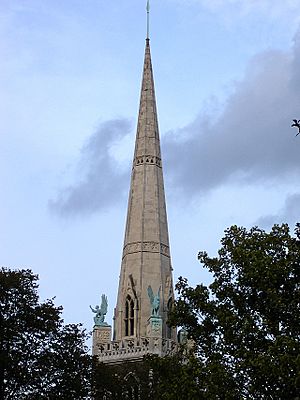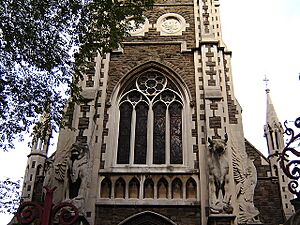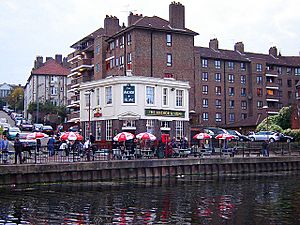Clapton, London facts for kids
Quick facts for kids Clapton |
|
|---|---|
 The steeple of the Cathedral of the Nativity of Our Lord (formerly the Good Shepherd) dominates the Upper Clapton skyline. |
|
| OS grid reference | TQ345875 |
| • Charing Cross | 5.6 mi (9.0 km) SW |
| London borough | |
| Ceremonial county | Greater London |
| Region | |
| Country | England |
| Sovereign state | United Kingdom |
| Post town | LONDON |
| Postcode district | E5 |
| Dialling code | 020 |
| Police | Metropolitan |
| Fire | London |
| Ambulance | London |
| EU Parliament | London |
| UK Parliament |
|
| London Assembly |
|
Clapton is a lively area in East London, England. It's part of the London Borough of Hackney. Clapton is split into two main parts: Upper Clapton in the north and Lower Clapton in the south. Clapton railway station is about 4.7 miles (7.6 km) north-east of Charing Cross, a famous spot in central London.
Contents
Exploring Clapton's Past and Present
Clapton started as a small village within the larger area of Hackney. It has grown a lot over the centuries.
How Did Clapton Get Its Name?
The name "Clapton" comes from old English words. It means "farm on the hill." This name was first recorded in 1339. The "hill" likely refers to the higher ground near the River Lea. Clapton grew along a main road, which is now known as Lower and Upper Clapton Road. As more people moved here, the area called Clapton grew to cover most of north-east Hackney.
What Are Clapton's Boundaries?
Clapton has never had official borders because it wasn't an administrative area. However, the E5 postcode area, created in 1917, helps people know where Clapton is. The E5 area covers most of north-east Hackney. To the east, Clapton borders the River Lea. Even though the postcode helps, some parts, like Clapton Common, are seen as part of Upper Clapton, even if they are outside the E5 postal district.
How Has Clapton Been Governed?
The old parish of Hackney separated from Stepney a long time ago. It had the same borders for many years. This area was part of the Tower Hamlets, which had special powers.
In 1900, the Metropolitan Borough of Hackney was formed. It used the same borders as the old parish. In 1965, Hackney joined with two other boroughs, Shoreditch and Stoke Newington. Together, they formed the modern London Borough of Hackney. This new borough became part of Greater London.
Upper and Lower Clapton: What's the Difference?
Clapton was originally a long, narrow village along a road. In the early 1800s, people started calling the northern part Upper Clapton and the southern part Lower Clapton. Lea Bridge Road is still used today to mark the difference between these two areas. Kenninghall Road, which extends from Lea Bridge Road, also helps to show where one part ends and the other begins.
Clapton Park is on the eastern side of Lower Clapton. It has old Victorian houses and newer buildings from after World War II. Chatsworth Road in Clapton Park has a popular Sunday market that started again in 2010.
Clapton Through the Centuries
Clapton has a rich history with some interesting buildings and events.
Brooke House: A Royal Connection

A large house called the King's House stood where BSix Sixth Form College is today. It was there as early as 1476. This house was part of a big estate of about 200 acres (0.8 km²).
In 1532, Henry Algernon Percy, the Earl of Northumberland, owned the estate. But in 1535, Henry VIII took the land to settle a debt. King Henry VIII visited the house in April 1535. Later that year, he gave the house to Thomas Cromwell, his chief minister. Cromwell made improvements to the house. In 1536, Mary I of England came to the house to take an important oath before her father, King Henry VIII, and Queen Jane Seymour. Henry VIII owned the house until he died in 1547.
The house later became known as Brooke House. This was after Fulke Greville, 1st Baron Brooke, bought it in 1621. His family owned it for over 200 years. After 1724, the house was rented out. In 1758, a renter named William Clarke changed it into a hospital for people with mental health conditions. It stayed this way until 1940.
The remains of Brooke House were badly damaged during World War II in October 1940. More damage happened in 1944. The house was finally taken down in 1954. New school buildings were built on the site in 1960.
Clapton Today: Recent Events
In 2011, parts of Clapton were affected by riots. Clarence Road was a central point for these events. In 2018, some areas of Clapton experienced flooding. This happened when a water pipe burst near Lea Bridge Road.
Special Places in Clapton
Clapton has many unique buildings and landmarks.
The Church of the Good Shepherd
Upper Clapton is home to a very unusual church called the Church of the Good Shepherd. It was built in 1892 by a group called the Agapemonites. They had some different ideas about marriage and women's roles.
The outside of the church is full of statues and symbols. The main doors have large carvings of angels and symbols for the four evangelists: a man, an eagle, a bull, and a lion. These same figures, made of bronze, look out from the base of the steeple. The stained glass windows were designed by a famous children's book artist, Walter Crane. They show the group's unique beliefs about women.
The church was finished in 1895. It was designed by Joseph Morris and his family, who were part of the group. The church has a Gothic Revival style. Because of its unique look, it became a Grade II-listed building in 1969. The Agapemonites eventually left the church. It was later used by the Ancient Catholic Church and then by the Georgian Orthodox Church in 2005.
The New Synagogue
Near the Church of the Good Shepherd is the beautiful New Synagogue. It's on the eastern side of Clapton Common. This Grade II listed building looks older than it is. It was built in 1915, but it's a copy of an older synagogue from the City of London. The current building has some original parts from the older one. The synagogue was restored in 2005.
Anchor and Hope Pub
The Anchor and Hope pub is close to Springfield Park. It survived the heavy bombing during World War II along the River Lea. It's one of the few old buildings left from the time when the area had many terraced houses. Now, it's surrounded by newer apartment buildings.
Clapton's Buildings and Homes
Many parts of Lower Clapton still look like they did in the late 1800s. Most of the homes are Victorian terraces. Some tall apartment buildings built in the 1960s and 1970s were taken down in the 1990s. They were replaced with lower-rise housing, like the Clapton Park Estate.
Green Spaces in Clapton
Clapton has many lovely parks and open areas for everyone to enjoy.
- Clapton Pond: This pond has been here since the 1600s. It was made into a public park in the late 1800s. In 2004, local groups raised money to improve it. Now, it's a busy and well-used community park. In 2022, Hackney Council upgraded the play area for local families.
- Springfield Park: This park was created in 1905 from the gardens of three private houses. One of these houses is still there and is now a cafe. Today, it's a local nature reserve.
- Clapton Square: This is a public garden square near Hackney Central. It was designed in 1816. It was meant for wealthy merchants and officers. It's now a Conservation Area, which means it's protected for its historical importance.
- Hackney Downs: This is a large park of about 40 acres (16 hectares) in Lower Clapton. It used to be common land.
- Clapton Common: This is a small area of former common land in Upper Clapton. A old toilet block from 1931 on the common was turned into Liberty Hall, a community space, in 2020.
- Hackney Marshes: Some parts of these famous marshes are also considered to be in Clapton.
- Millfields Park: This park was created in 1884. It borders the Lea River and its walking paths. It has tennis courts, basketball courts, a cricket pitch, and modern play areas for children. A local group works to improve the park for residents and nature. The park has received the Green Flag Award, which means it's a well-managed green space.
- Daubeney Fields: This 11-acre park is part of the old Hackney Marsh. It includes the Hackney Bumps skatepark, which was built in 1986 and updated in 2019.
Sports in Clapton
Clapton has a history with football. Clapton F.C. was the first local football team, formed in 1878. Clapton Community FC started in 2018. Leyton Orient, another well-known club, played as Clapton Orient before moving to Leyton in 1937.
Schools in Clapton
Clapton has several schools for young people. Secondary schools include Clapton Girls' Academy and Mossbourne Community Academy. Mossbourne is built on the site of the former Hackney Downs School. BSix Sixth Form College is a college for older students near the Lea Bridge Roundabout.
Primary schools include Millfields Community School, which was visited by Tony Blair in 2005. Mandeville Primary School is another local school. It's known for its Hackney School of Food, which is a professional teaching kitchen and community garden.
Images for kids
-
Maccaronis were 18th-century dandies. This example from 1792 is from Sutton House.










